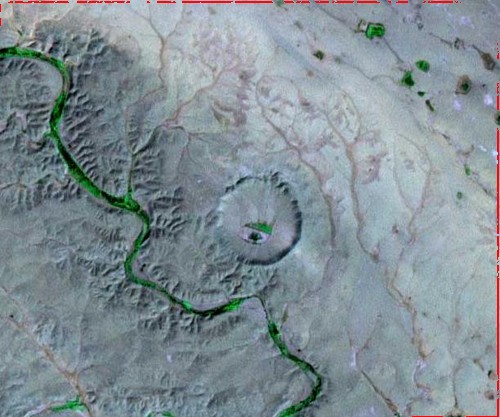
home •
about •
essential guide •
picture of the day •
thunderblogs •
news •
multimedia •
predictions •
products •
get involved •
contact

Credit: Landsat ETM
Talemzane Crater in Algeria
pic of the day
archive
subject index
abstract
archive
Links:
Society for
Interdisciplinary
Studies
Aug 12, 2005
Richat Crater Revisited (2)
Why is it so difficult to find evidence of impacts for these craters? And why are their features so unlike those expected from impact craters? Both questions are answered if these craters were electrically machined by rotating Birkeland currents.
Electric Discharge Machined (EDM) craters of these sizes require a discharge between Earth and a celestial visitor coming close. Chunks of charged material in orbit around the visitor, while being swept up by the Earth, would puncture the Earth's double-layer Langmuir sheath and leave ionized trails to the Earth. Such trails would be paths of least resistance for an ensuing discharge arc from the visitor. The discharges would likely fragment the chunks, and the fragments could impact around the craters. But the craters themselves are clearly from EDM because, among other distinctive features, the crater bottoms show no sign of impact fracturing.
Talemzane Crater. 1.75km diameter
http://www.image-contrails.de/algeria/index.html
and click on “display crater map”
The Talemzane crater, shown in the two different images above, is located in Algeria, close to the Richat Crater area. Projectiles of limestone block of up to 10m make up the crest of the rim.
The Global Impact Studies Project states:
"There is petrographic evidence for Talemzane's impact origin. Thin sections cut from several different rocks have revealed planar elements in quartz, sometimes accompanied by fluid inclusions. Although no other evidence of shock metamorphism has been found, planar elements in quartz are a fairly conclusive sign of an impact event." But Project scientists have not considered all possibilities: These elements are only a sign of shock, and an interplanetary thunderbolt would produce quite “shocking” thunder.
Although Talemzane is somewhat out of alignment with the Richat group one must take into account the Earth's rotation. This would indicate that the celestial visitor approached from the north-east and the main discharge activity took place at what is now Richat Crater. When there are high current flows during DC arcing there are forces that "grip" between the anode and cathode. It would be quite possible for a celestial body passing another celestial body to have its course altered by strong plasma discharges.
Aouelloul Crater, Diameter 390 m.
Aouelloul is located in Ordovician sandstones and quartzite in the western Sahara Desert, Mauritania and is one of the smaller craters.
Again, in regard to "impact" evidence, the Global Impact Studies Project states:
"The rim is
well-defined and rises 15-25m above the local topography, and 53m
above the crater floor. ...While breccias are not found at Aouelloul,
impact glass can be found on the south, southeast, and north outer
part of the crater rim. Because the glass is enriched in siderophile
elements, has a low water content, and contains lechatelierite (a
product of shock deformation), it has been interpreted as an impact
glass."
"Proving Allouelloul’s impact origin has proved extremely difficult....
Instead of relying on petrography, scientists have used chemical
analysis to prove an impact origin here. While most of the glass is
compositionally similar to the local Zli sandstone, the glass does
have high concentrations of Fe, Co, Ni, and Ir. All of these
elements are extremely common in stony meteorites, and then ratios
in the impact glass are consistent with ratios seen in meteorites.
In addition, the Re-OS isotope ratios of the glass were measured.
This method examines the admixture of small amounts of recondensed
material with low Os ratios to target rocks with high Os ratios.
"At Aouelloul, the Os ratios of the impact glass are extremely
similar to those of both chondritic and iron meteorites. This
suggests that the Os present in the glass came from a meteorite, as
the amount present is much too high to have had a terrestrial
origin."
Again, the Project conclusion (of impact) is premature: An interplanetary thunderbolt would also melt siderophile debris into glass. In fact, the question is still open about how much melting an impact can produce: Laboratory impacts expend most of their energy in shock displacement. Material suddenly “flows” in a starburst pattern and just as suddenly “freezes” again. Very little melting occurs, because the energy is dissipated too quickly for conduction to raise materials to their melting points. Electric discharge, on the other hand, can directly heat the material.
Quarkziz crater, 3.5km in diameter
See: http://www.image-contrails.de/algeria/index.html
The Quarkziz crater is another that is in the same region as the Richat aligned craters. Again, regarding the impact issue, the Global Impact Studies Project states:
"The Quarkziz crater is located in western Algeria, close to the Moroccan border. The crater is 3.5km in diameter, and has a central uplift structure. The external rim has a height of 100m from top to bottom, and is made up of strongly dipping sedimentary rocks...."
"Quarkziz has limited evidence of an impact origin, in that no impact glass or meteorite fragments have been found. However, petrographic studies have identified planar deformation features in quartzites from the central uplift structure, and from the outer edges of the crater...."
As noted above, the presence of shocked quartz doesn’t distinguish between impact and thunderbolt.
A final datum
What should be disconcerting to "impact" theorists is that in dozens of craters studied closely around the Earth, meteorite fragments were documented in only three.
See also:
Apr 07, 2005 Earth's
Richat Crater
Aug 11, 2005
Richat Revisited
Composed by Shaun Bourke and Michael Armstrong
EXECUTIVE EDITORS:
David Talbott, Wallace Thornhill
MANAGING EDITOR:
Mel Acheson
CONTRIBUTING EDITORS: Michael Armstrong, Dwardu Cardona, Ev Cochrane,
C.J. Ransom, Don Scott, Rens van der Sluijs, Ian Tresman
WEBMASTER: Michael Armstrong
Copyright 2005: thunderbolts.info